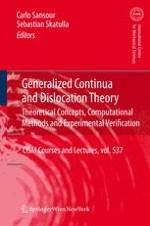Defects, dislocations and the general theory.- Approaches to generalized continua.- Generalized continuum modelling of crystal plasticity.- Introduction to discrete dislocation dynamics.
The book contains four lectures on generalized continua and dislocation theory, reflecting the treatment of the subject at different scales. G. Maugin provides a continuum formulation of defects at the heart of which lies the notion of the material configuration and the material driving forces of in-homogeneities such as dislocations, disclinations, point defects, cracks, phase-transition fronts and shock waves. C. Sansour and S. Skatulla start with a compact treatment of linear transformation groups with subsequent excursion into the continuum theory of generalized continua. After a critical assessment a unified framework of the same is presented. The next contribution by S. Forest gives an account on generalized crystal plasticity. Finally, H. Zbib provides an account of dislocation dynamics and illustrates its fundamental importance at the smallest scale. In three contributions extensive computational results of many examples are presented.
